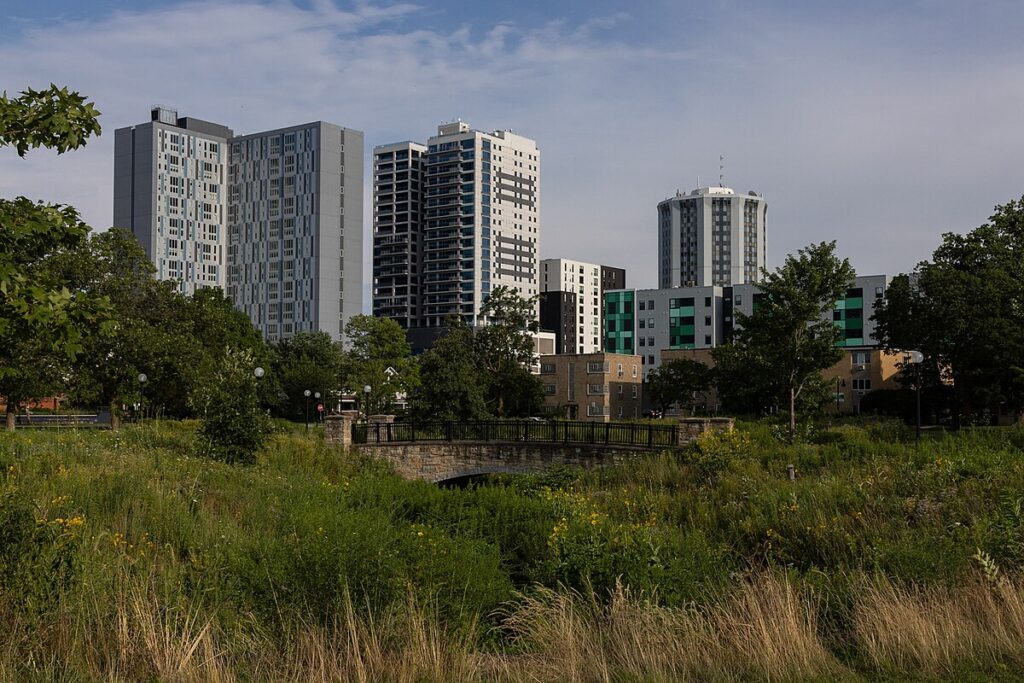
Moving to Champaign, Illinois: A Comprehensive Relocation Guide
Considering moving to Champaign, Illinois? This vibrant college city offers University of Illinois energy, tech growth, and Central Illinois character. With approximately 89,000 residents in 2025 (metro 237,000+ with Urbana), Champaign combines Big Ten atmosphere with research employment and Illinois’ premier university community.
Demographic Profile to Consider If Moving to Champaign:
Champaign’s 2025 population is approximately 89,000 residents, forming a twin-city metro with Urbana totaling over 237,000 in Champaign County. The median age is around 26 years, heavily influenced by the University of Illinois at Urbana-Champaign. The population is approximately 63% White, 15% Asian, 12% Black or African American, 7% Hispanic. Champaign features the UI campus, downtown Campustown serving students, residential neighborhoods, and Research Park attracting technology companies. The city attracts students, academics, tech workers, and families seeking college-town amenities. Champaign appeals to educated professionals, university employees, and those valuing Big Ten athletics and intellectual atmosphere. The community values education, innovation, diversity, and college sports.
Cost of Living to Consider If Moving to Champaign:
Champaign offers exceptional affordability for a major university city. Median home values range from $180,000 to $260,000 in 2025, providing tremendous value with college amenities and employment. The median household income is approximately $52,000, reflecting the large student population. Rental properties average $1,000 to $1,600 monthly, with abundant student housing. Illinois’ state income tax is flat 4.95%. Property taxes are moderate. Overall cost of living is very low for the cultural offerings and Big Ten atmosphere, making Champaign highly attractive for university employees, young professionals, tech workers, and families. The city provides exceptional value with research employment and college amenities. Housing costs create accessibility while maintaining quality of life.
Economy and Job Market:
Champaign’s economy centers on the University of Illinois (massive employer with faculty, staff, research), healthcare, technology, and government. UI is the dominant force employing thousands and driving innovation. Carle Health System and OSF HealthCare provide extensive medical employment. Research Park at Illinois attracts technology companies and startups capitalizing on university talent. State Farm has operations. Champaign County government provides employment. Typical industries include education, research, healthcare, technology, and government. The diverse economy benefits from university stability and tech sector growth. The job market attracts professionals seeking research employment, tech opportunities, and academic positions with affordable living.
Education:
Champaign Unit 4 School District and Urbana School District 116 serve area students with schools including Centennial High School and Central High School. School quality varies requiring family research. The University of Illinois at Urbana-Champaign is a world-class research university and Big Ten powerhouse offering comprehensive programs. Parkland College provides community college programs. The concentration of higher education creates intellectual atmosphere and graduates talent feeding local tech economy.
Recreation and Lifestyle:
Champaign offers vibrant college-town culture centered on University of Illinois athletics with Fighting Illini football at Memorial Stadium and basketball at State Farm Center creating massive community events. Downtown Champaign and Campustown feature restaurants, bars, entertainment serving students and residents. The Virginia Theatre presents performances. Museums including Krannert Art Museum enrich culture. Residents enjoy extensive parks, trails, and the Japan House at UI. The lifestyle emphasizes Big Ten sports passion, intellectual discourse, diverse dining, and college atmosphere. The four-season climate enables varied activities. The community values education, innovation, Fighting Illini pride, and intellectual engagement. Living in Champaign means embracing college-town character (student population, game day culture), accepting Central Illinois isolation (2+ hours to Chicago), and prioritizing intellectual atmosphere and Big Ten sports with exceptional affordability and research employment creating unique blend of college energy and tech innovation.
Healthcare and Services:
Champaign residents access comprehensive healthcare through Carle Foundation Hospital, OSF Heart of Mary Medical Center, and extensive medical facilities. The twin cities serve as East Central Illinois’ healthcare hub with quality medical care and university medical research.
Transportation:
Champaign is accessed via Interstate 57, Interstate 74, and various corridors. University of Illinois Willard Airport provides limited commercial service. Champaign-Urbana Mass Transit District (MTD) operates extensive bus service throughout the twin cities and campus. Most permanent residents use personal vehicles though students often bike or use transit. Typical travel times to Chicago are 2-2.5 hours.
Conclusion:
Moving to Champaign in 2025 offers vibrant college city living with Fighting Illini athletics, tech growth, and university atmosphere. The community’s combination of Big Ten sports, research employment, and exceptional affordability makes it ideal for academics, tech workers, students, and families seeking Illinois’ premier university community where Illini pride meets innovation and college energy defines affordable Central Illinois living with world-class research university.

